Page 7 of 344
5
3008_en_Chap00b_vue-ensemble_ed01-2015
Interior
Storage compartments under the footwells 1 00
Rear seats
7
2-73
Side blinds
1
08
Temporary puncture repair kit
2
03-208
Spare wheel
2
09 -213
Tool kit
2
01-202
Access to the AdBlue
® tank 1 98 -200
Conventional child seats
1
09 -117
ISOFIX child seats
1
18 -121
Child lock
1
22
Rear armrest
1
00
Ski flap
1
00
Adjustable boot floor
1
07
Boot fittings
1
03 -106
-
l
oad space space cover
-
hooks
-
1
2 V accessory socket
-
l
uggage retaining net
-
s
torage box
Boot lamp
9
3
Rear multimedia
9
8 -99
Seat belts
1
29 -131
Mats
97
A
ir bags
132-13 5
Deactivating the passenger's front a i r b a g
111
, 13 3
Front seats
6
7-71
-
manual
-
electric
-
h
ead restraints
-
lumbar
-
heated
Seat in table position, transporting long objects
7
1
.
Over view
Page 15 of 344
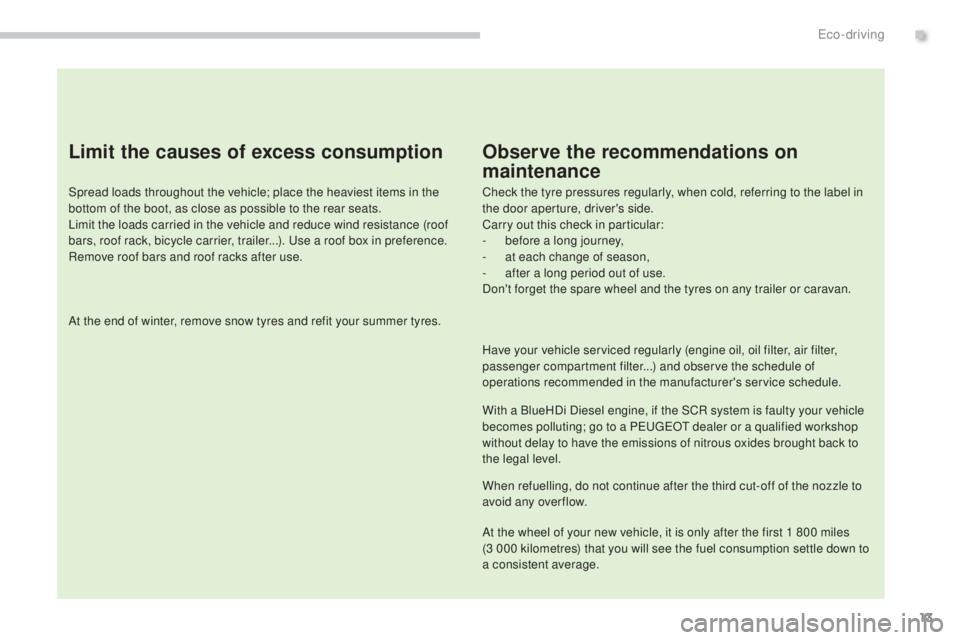
13
3008_en_Chap00c_eco-conduite_ed01-2015
Limit the causes of excess consumption
Spread loads throughout the vehicle; place the heaviest items in the
bottom of the boot, as close as possible to the rear seats.
Limit the loads carried in the vehicle and reduce wind resistance (roof
bars, roof rack, bicycle carrier, trailer...). Use a roof box in preference.
Remove roof bars and roof racks after use.
At the end of winter, remove snow tyres and refit your summer tyres.
Observe the recommendations on
maintenance
Check the tyre pressures regularly, when cold, referring to the label in
the door aperture, driver's side.
Carry out this check in particular:
-
b
efore a long journey,
-
a
t each change of season,
-
a
fter a long period out of use.
Don't forget the spare wheel and the tyres on any trailer or caravan.
Have your vehicle serviced regularly (engine oil, oil filter, air filter,
passenger compartment filter...) and observe the schedule of
operations recommended in the manufacturer's service schedule.
With a BlueHDi Diesel engine, if the SCR system is faulty your vehicle
becomes polluting; go to a PEUGEOT dealer or a qualified workshop
without delay to have the emissions of nitrous oxides brought back to
the legal level.
When refuelling, do not continue after the third cut-off of the nozzle to
avoid any over flow.
At the wheel of your new vehicle, it is only after the first 1 800 miles
(3
000 kilometres) that you will see the fuel consumption settle down to
a consistent average.
.
Eco-driving
Page 107 of 344
105
3008_en_Chap05_amenagements_ed01-2015
The hooks can be used to secure shopping
bags.
Hooks
To store it at the bottom of the boot:
F r emove the load space cover as described
above,
F
p
lace the floor at an angle,
F
p
lace the load space cover in its location
(recess marked A ), at bottom of the boot,
F
t
he load space cover will be protected
if you place the floor in the intermediate
position. To put it back in place:
F
t ake hold of the load space cover with both
hands then place it on its support,
F
u
nfold it to the boot pillars,
F
h
ook the two cords,
F
i
f necessary, press on the top of the load
space cover, on the left and on the right, to
engage the fixings.
When changing a wheel
The hooks facilitate access to the spare
wheel, retaining the boot carpet by
means of the two cords.
5
Fittings
Page 174 of 344
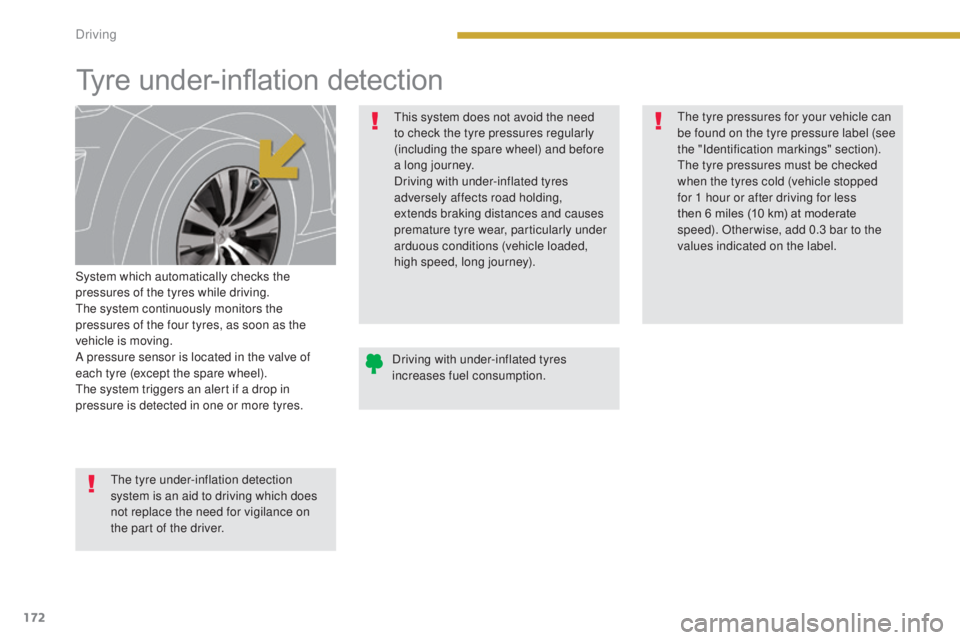
172
3008_en_Chap08_conduite_ed01-2015
Tyre under-inflation detection
System which automatically checks the
pressures of the tyres while driving.
The system continuously monitors the
pressures of the four tyres, as soon as the
vehicle is moving.
A pressure sensor is located in the valve of
each tyre (except the spare wheel).
The system triggers an alert if a drop in
pressure is detected in one or more tyres.This system does not avoid the need
to check the tyre pressures regularly
(including the spare wheel) and before
a long journey.
Driving with under-inflated tyres
adversely affects road holding,
extends braking distances and causes
premature tyre wear, particularly under
arduous conditions (vehicle loaded,
high speed, long journey).
The tyre pressures for your vehicle can
be found on the tyre pressure label (see
the "Identification markings" section).
The tyre pressures must be checked
when the tyres cold (vehicle stopped
for 1 hour or after driving for less
then
6 miles (10 km) at moderate
speed). Other wise, add 0.3 bar to the
values indicated on the label.
Driving with under-inflated tyres
increases fuel consumption.
The tyre under-inflation detection
system is an aid to driving which does
not replace the need for vigilance on
the part of the driver.
Driving
Page 175 of 344
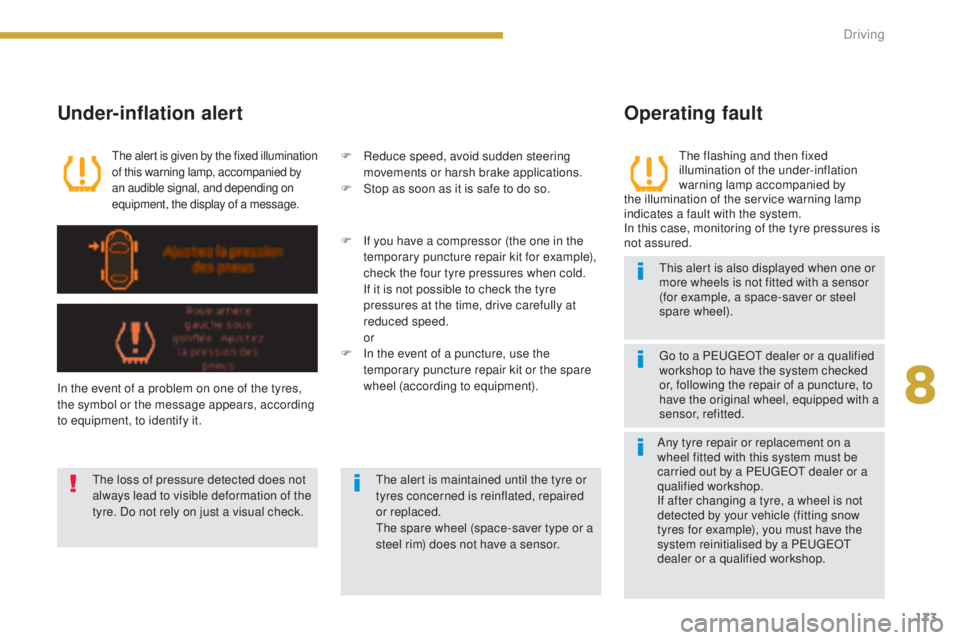
173
3008_en_Chap08_conduite_ed01-2015
The flashing and then fixed
illumination of the under-inflation
warning lamp accompanied by
the illumination of the service warning lamp
indicates a fault with the system.
In this case, monitoring of the tyre pressures is
not assured.
This alert is also displayed when one or
more wheels is not fitted with a sensor
(for example, a space-saver or steel
spare wheel).
Under-inflation alert
The alert is given by the fixed illumination
of this warning lamp, accompanied by
an audible signal, and depending on
equipment, the display of a message.
In the event of a problem on one of the tyres,
the symbol or the message appears, according
to equipment, to identify it. F
R
educe speed, avoid sudden steering
movements or harsh brake applications.
F
S
top as soon as it is safe to do so.
The loss of pressure detected does not
always lead to visible deformation of the
tyre. Do not rely on just a visual check. The alert is maintained until the tyre or
tyres concerned is reinflated, repaired
or replaced.
The spare wheel (space-saver type or a
steel rim) does not have a sensor.
Operating fault
Go to a PEUGEOT dealer or a qualified
workshop
to have the system checked
or, following the repair of a puncture, to
have the original wheel, equipped with a
sensor, refitted.
F
I
f you have a compressor (the one in the
temporary puncture repair kit for example),
check the four tyre pressures when cold.
I
f it is not possible to check the tyre
pressures at the time, drive carefully at
reduced speed.
or
F
I
n the event of a puncture, use the
temporary puncture repair kit or the spare
wheel (according to equipment).
Any tyre repair or replacement on a
wheel fitted with this system must be
carried out by a PEUGEOT dealer or a
qualified workshop.
If after changing a tyre, a wheel is not
detected by your vehicle (fitting snow
tyres for example), you must have the
system reinitialised by a PEUGEOT
dealer or a qualified workshop.
8
Driving
Page 203 of 344
201
3008_en_Chap10_infos-pratiques_ed01-2015
Tool kit
This is a set of tools provided with the vehicle. The content depends on your vehicle's equipment (temporary puncture repair kit or spare wheel).
Access to the tools
The main tools are stowed in the boot under
t h e f l o o r.
For access to them:
F
o
pen the boot,
F
p
lace the adjustable boot floor at an angle
(refer to the "Fittings" section),
F
r
aise the floor,
F
s
ecure it by hooking its cords on the hooks
on the load space cover support,
For versions with a standard or
"space-saver" spare wheel
F remove the polystyrene storage box,
F u nclip by pulling at the top then remove the
carrier containing the tools.
For BlueHDi versions with
"space-saver" spare wheel
F remove the spare wheel,
F r emove the polystyrene storage box,
F
p
ush the jack for wards then lift it at the
r e a r.
10
Practical information
Page 204 of 344
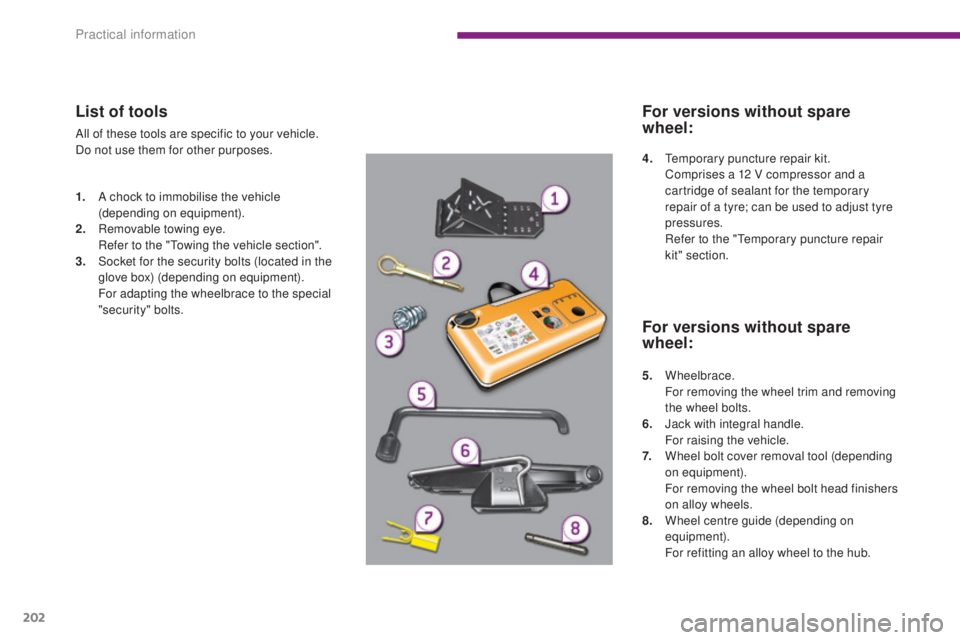
202
3008_en_Chap10_infos-pratiques_ed01-2015
List of tools
All of these tools are specific to your vehicle.
Do not use them for other purposes.
1.
A c
hock to immobilise the vehicle
(depending on equipment).
2.
R
emovable towing eye.
R
efer to the "Towing the vehicle section".
3.
S
ocket for the security bolts (located in the
glove box) (depending on equipment).
F
or adapting the wheelbrace to the special
"security" bolts. 4.
T
emporary puncture repair kit.
C
omprises a 12 V compressor and a
cartridge of sealant for the temporary
repair of a tyre; can be used to adjust tyre
pressures.
R
efer to the "Temporary puncture repair
kit" section.
5.
Wheelbrace.
F
or removing the wheel trim and removing
the wheel bolts.
6.
J
ack with integral handle.
F
or raising the vehicle.
7.
W
heel bolt cover removal tool (depending
on equipment).
F
or removing the wheel bolt head finishers
on alloy wheels.
8.
W
heel centre guide (depending on
equipment).
F
or refitting an alloy wheel to the hub.
For versions without spare
wheel:
For versions without spare
wheel:
Practical information
Page 211 of 344
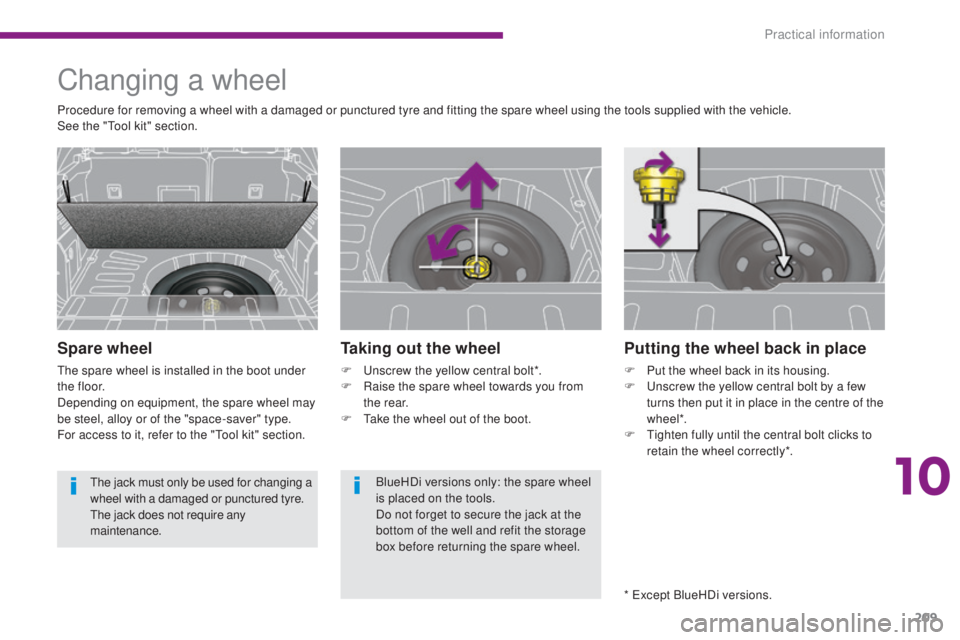
209
3008_en_Chap10_infos-pratiques_ed01-2015
Putting the wheel back in place
F Put the wheel back in its housing.
F U nscrew the yellow central bolt by a few
turns then put it in place in the centre of the
w h e e l*.
F
T
ighten fully until the central bolt clicks to
retain the wheel correctly*.
Changing a wheel
Spare wheel
The spare wheel is installed in the boot under
t h e f l o o r.
Depending on equipment, the spare wheel may
be steel, alloy or of the "space-saver" type.
For access to it, refer to the "Tool kit" section.
Taking out the wheel
F Unscrew the yellow central bolt*.
F R aise the spare wheel towards you from
the rear.
F
T
ake the wheel out of the boot.
Procedure for removing a wheel with a damaged or punctured tyre and fitting the spare wheel using the tools supplied with the vehicle.
See the "Tool kit" section.
* Except BlueHDi versions.
BlueHDi versions only: the spare wheel
is placed on the tools.
Do not forget to secure the jack at the
bottom of the well and refit the storage
box before returning the spare wheel.
The jack must only be used for changing a
wheel with a damaged or punctured tyre.
The jack does not require any
maintenance.
10
Practical information